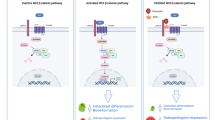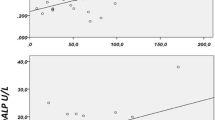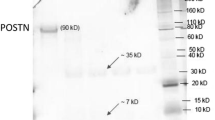Abstract
The aim of our study was to investigate the sex- and age-related changes of serum Dickkopf-1 (Dkk-1), a soluble inhibitor of the Wnt signaling pathway, in healthy individuals and in patients with breast cancer (BC) and bone metastases (BM) using a new ELISA. Association of serum Dkk-1 with markers of bone turnover was also investigated. Serum Dkk-1 measurements were performed using a commercial sandwich ELISA in 150 healthy men, 175 healthy pre- and postmenopausal women (20–65 years), 22 women with BC and BM (mean age 63 years), and 16 women with BC and metastases at sites other than bone (mean age 53 years). Intra- and interassay coefficients of variation were below 7% and 12%, respectively. The detection limit was determined to be 0.018 μg/L. In healthy women and men, Dkk-1 did not change with age. Serum Dkk-1 modestly correlated with serum bone alkaline phosphatase (r = 0.19, P = 0.013) and serum C-terminal cross-linking telopeptide of type I collagen (r = 0.19, P = 0.014) in women but not in men. Dkk-1 levels were higher in women with BC and BM (5.57 ± 5.50 μg/L) than in healthy age-matched controls (3.47 ± 1.47 μg/L, P < 0.0001) and women with metastases at sites other than bone (3.57 ± 1.66 μg/L, P = 0.0003). In conclusion, serum Dkk-1 is stable with age in healthy women and men and increases in patients with BC and BM. Measurements of circulating Dkk-1 with this new ELISA may be useful for the clinical investigation of patients with malignant bone diseases.




Similar content being viewed by others
References
Wodarz A, Nusse R (1998) Mechanisms of Wnt signaling in development. Annu Rev Cell Dev Biol 14:59–88
Huelsken J, Birchmeier W (2001) New aspects of Wnt signaling pathways in higher vertebrates. Curr Opin Genet Dev 11:547–553
Miller JR (2002) The Wnts. Genome Biol 3:3001.1–3001.15
Sharpe C, Lawrence N, Martinez Arias A (2001) Wnt signalling: a theme with nuclear variations. Bioessays 23:311–318
Kuhl M, Sheldahl LC, Park M, Miller JR, Moon RT (2000) The Wnt/Ca2 pathway: a new vertebrate Wnt signaling pathway takes shape. Trends Genet 16:279–283
Weston CR, Davis RJ (2002) The JNK signal transduction pathway. Curr Opin Genet Dev 12:14–21
Zorn AM (2001) Wnt signaling: antagonistic dickkopfs. Curr Biol 11:R592–R595
Jones SE, Jomary C (2002) Secreted Frizzled-related proteins: searching for relationships and patterns. Bioessays 24:811–820
Church VL, Francis-West P (2002) Wnt signaling during limb development. Int J Dev Biol 46:927–936
Patel MS, Karsenty G (2002) Regulation of bone formation and vision by LRP5. N Engl J Med 346:1572–1574
Goltzman D (2002) Discoveries, drugs and skeletal disorders. Nat Rev Drug Discov 1:784–796
Boyden LM, Mao J, Belsky J, Mitzner L, Farhi A, Mitnick MA, Wu D, Insogna K, Lifton RP (2002) High bone density due to a mutation in LDL-receptor-related protein 5. N Engl J Med 346:1513–1521
Diarra D, Stolina M, Polzer K, Zwerina J, Ominsky MS, Dwyer D, Korb A, Smolen J, Hoffmann M, Scheinecker C, van der Heide D, Landewe R, Lacey D, Richards WG, Schett G (2007) Dickkopf-1 is a master regulator of joint remodeling. Nat Med 13:156–163
Lane NE, Nevitt MC, Lui LY, de Leon P, Corr M (2007) Study of Osteoporotic Fractures Research Group (2007) Wnt signaling antagonists are potential prognostic biomarkers for the progression of radiographic hip osteoarthritis in elderly Caucasian women. Arthritis Rheum 56:3319–3325
Naot D, Bava U, Matthews B, Callon KE, Gamble GD, Black M, Song S, Pitto RP, Cundy T, Cornish J, Reid IR (2007) Differential gene expression in cultured osteoblasts and bone marrow stromal cells from patients with Paget’s disease of bone. J Bone Miner Res 22:298–309
Tian E, Zhan F, Walker R, Rasmussen E, Ma Y, Barlogie B, Shaughnessy JD Jr (2003) The role of the Wnt-signaling antagonist DKK1 in the development of osteolytic lesions in multiple myeloma. N Engl J Med 349:2483–2494
Politou MC, Heath DJ, Rahemtulla A, Szydlo R, Anagnostopoulos A, Dimopoulos MA, Dimopoulos MA, Croucher PI, Terpos E (2006) Serum concentrations of Dickkopf-1 protein are increased in patients with multiple myeloma and reduced after autologous stem cell transplantation. Int J Cancer 119:1728–1731
Hall CL, Bafico A, Dai J, Aaronson SA, Keller ET (2005) Prostate cancer cells promote osteoblastic bone metastases through Wnts. Cancer Res 65:7554–7560
Hall CL, Daignault SD, Shah RB, Pienta KJ, Keller ET (2008) Dickkopf-1 expression increases early in prostate cancer development and decreases during progression from primary tumor to metastasis. Prostate 68:1396–1404
Voorzanger-Rousselot N, Goehrig D, Journe F, Body JJ, Clézardin P, Garnero P (2007) Increased dickkopf-1 (Dkk-1) expression in breast cancer bone metastases. Br J Cancer 97:964–970
Garnero P, Borel O, Delmas PD (2001) Evaluation of a fully automated serum assay for C-terminal cross-linking telopeptide of type I collagen in osteoporosis. Clin Chem 47:694–702
Perco P, Rapberger R, Siehs C, Lukas A, Oberbaer R, Mayer G, Mayer B (2006) Transforming omics data into context: bioinformatics on genomics and proteomics raw data. Electrophoresis 27:2659–2675
Yamabuki T, Takano A, Hayama S, Ishikawa N, Kato T, Miyamoto M, Ito T, Ito H, Miyagi Y, Nakayama H, Fujita M, Hosokawa M, Tsuchiya E, Kohno N, Kondo S, Nakamura Y, Daigo Y (2007) Dikkopf-1 as a novel serologic and prognostic biomarker for lung and esophageal carcinomas. Cancer Res 67:2517–2525
Voorzanger-Rousselot N, Journe F, Maitzen S, Hawa G, Lukas A, Body JJ, Garnero P (2007) Evaluation of a new two-site ELISA for serum Dkk-1 in patients with breast cancer and bone metastases [abstract]. Calcif Tissue Int 80:S71
Del Campo MT, Gonzalez-Casaus ML, Aguado P, Bernad M, Carrera F, Martinez ME (1999) Effects of age, menopause and osteoporosis on free, peptide-bound and total pyridinium crosslink excretion. Osteoporos Int 9:449–454
Liu JM, Zhao HY, Ning G, Zhao YJ, Chen Y, Zh Zhang, Sun LH, Xu MY, Chen JL (2005) Relationships between the changes of serum levels of OPG and RANKL with age, menopause, bone biochemical markers and bone mineral density in Chinese women aged 20–75. Calcif Tissue Int 76:1–6
Szulc P, Hofbauer LC, Heufelder AE, Roth S, Delmas PD (2001) Osteoprotegerin serum levels in men: correlation with age, estrogen, and testosterone status. J Clin Endocrinol Metab 86:3162–3165
Szulc P, Garnero P, Munoz F, Marchand F, Delmas PD (2001) Cross-sectional evaluation of bone metabolism in men. J Bone Miner Res 16:1642–1650
Kawano Y, Kypta R (2003) Secreted antagonists of the Wnt signalling pathway. J Cell Sci 116:2627–2634
Morvan F, Boulukos K, Clement-Lacroix P, Roman S, Suc-Royer I, Vayssiere B, Ammann P, Martin P, Pinho S, Pognonec P, Mollat P, Niehrs C, Baron R, Rawadi G (2006) Deletion of a single allele of the Dkk1 gene leads to an increase in bone formation and bone mass. J Bone Miner Res 21:934–945
Glass DAII, Karsenty G (2006) Canonical Wnt signaling in osteoblasts is required for osteoclast differentiation. Ann N Y Acad Sci 1068:117–130
Rogers A, Eastell R (2005) Circulating osteoprotegerin and receptor activator for nuclear factor kappaB ligand: clinical utility in metabolic bone disease assessment. J Clin Endocrinol Metab 90:6323–6331
Eghbali-Fatourechi G, Khosla S, Sanyal A, Boyle WJ, Lacey DL, Riggs BL (2003) Role of RANK ligand in mediating increased bone resorption in early postmenopausal women. J Clin Invest 111:1221–1230
Acknowledgements
We thank Dr. Gerhard Hawa for collaboration and Ms. Sonja Maitzen for technical assistance.
Author information
Authors and Affiliations
Corresponding author
Rights and permissions
About this article
Cite this article
Voorzanger-Rousselot, N., Journe, F., Doriath, V. et al. Assessment of Circulating Dickkopf-1 with a New Two-Site Immunoassay in Healthy Subjects and Women with Breast Cancer and Bone Metastases. Calcif Tissue Int 84, 348–354 (2009). https://doi.org/10.1007/s00223-009-9225-y
Received:
Accepted:
Published:
Issue Date:
DOI: https://doi.org/10.1007/s00223-009-9225-y




